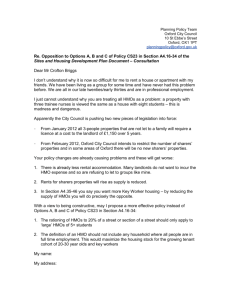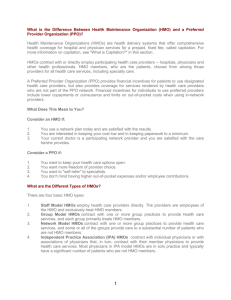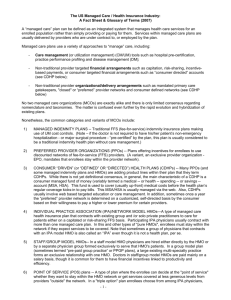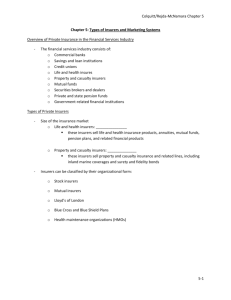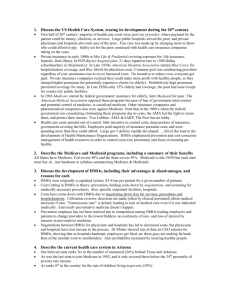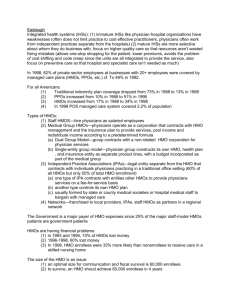The Private Health Insurance Market
advertisement
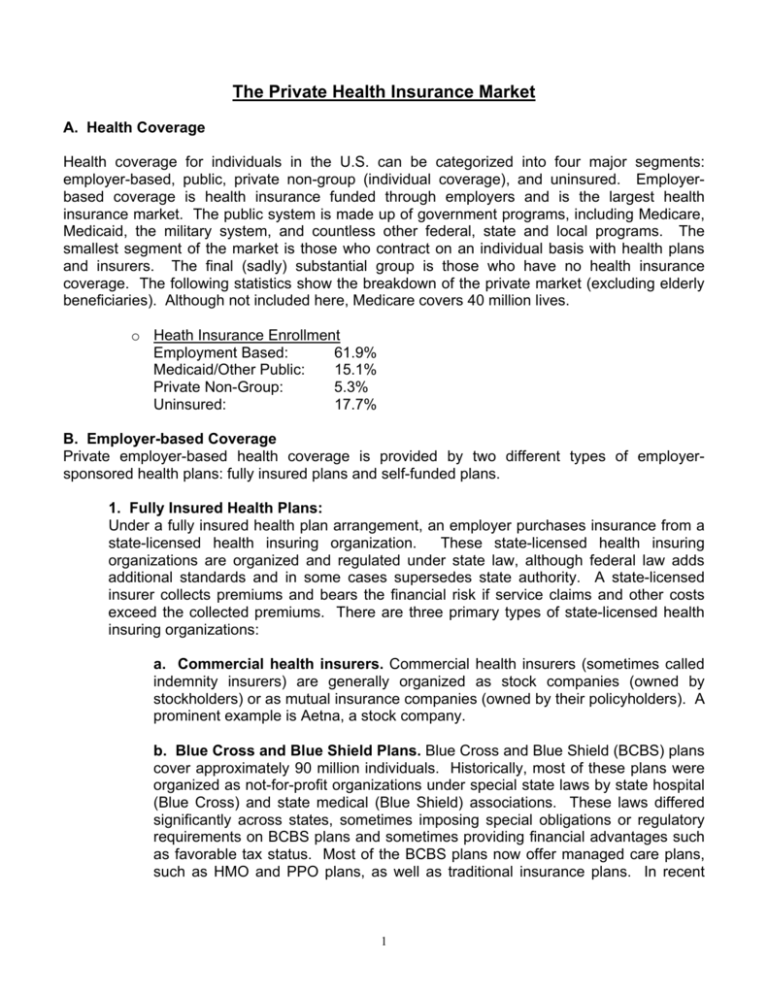
The Private Health Insurance Market A. Health Coverage Health coverage for individuals in the U.S. can be categorized into four major segments: employer-based, public, private non-group (individual coverage), and uninsured. Employerbased coverage is health insurance funded through employers and is the largest health insurance market. The public system is made up of government programs, including Medicare, Medicaid, the military system, and countless other federal, state and local programs. The smallest segment of the market is those who contract on an individual basis with health plans and insurers. The final (sadly) substantial group is those who have no health insurance coverage. The following statistics show the breakdown of the private market (excluding elderly beneficiaries). Although not included here, Medicare covers 40 million lives. o Heath Insurance Enrollment Employment Based: 61.9% Medicaid/Other Public: 15.1% Private Non-Group: 5.3% Uninsured: 17.7% B. Employer-based Coverage Private employer-based health coverage is provided by two different types of employersponsored health plans: fully insured plans and self-funded plans. 1. Fully Insured Health Plans: Under a fully insured health plan arrangement, an employer purchases insurance from a state-licensed health insuring organization. These state-licensed health insuring organizations are organized and regulated under state law, although federal law adds additional standards and in some cases supersedes state authority. A state-licensed insurer collects premiums and bears the financial risk if service claims and other costs exceed the collected premiums. There are three primary types of state-licensed health insuring organizations: a. Commercial health insurers. Commercial health insurers (sometimes called indemnity insurers) are generally organized as stock companies (owned by stockholders) or as mutual insurance companies (owned by their policyholders). A prominent example is Aetna, a stock company. b. Blue Cross and Blue Shield Plans. Blue Cross and Blue Shield (BCBS) plans cover approximately 90 million individuals. Historically, most of these plans were organized as not-for-profit organizations under special state laws by state hospital (Blue Cross) and state medical (Blue Shield) associations. These laws differed significantly across states, sometimes imposing special obligations or regulatory requirements on BCBS plans and sometimes providing financial advantages such as favorable tax status. Most of the BCBS plans now offer managed care plans, such as HMO and PPO plans, as well as traditional insurance plans. In recent 1 years, several of the state BCBS plans have reorganized themselves as for-profit organizations and now operate like commercial insurers. c. Health Maintenance Organizations (HMOs). HMOs cover approximately 70 million people. HMOs usually are licensed under special state laws that recognize that they tightly integrate health insurance with the provision of health care. HMOs operate as insurers and as health care providers. In many states, HMO regulation is shared by agencies that oversee insurance and agencies that oversee heath care providers. Examples of state licensed HMOs include Kaiser Permanente and Harvard Pilgrim. 2. Self-Funded Employee Health Benefit Plans Under a self-funded plan arrangement, the plan sponsor, such as an employer or employee organization, retains the responsibility to pay directly for health care services of the plan’s participants. In a self-funded plan, the employer reserves funds to pay claims and merely pays an administrative fee to a third party. With a self-funded plan, the employer bears most of the financial risk. In most cases, the sponsors of self-funded health plans contract with one or more third parties to administer the plans. These contracts are sometimes with entities that specialize in administering benefit plans, called third-party administrators. In other cases, sponsors contract with health insurers or HMOs for administrative services. The administering entity usually will manage the health benefits in the same way as a health insurer or HMO, but will pay for the cost of medical care with funds provided by the sponsor. C. Types of Managed Care In today’s insurance market, approximately two-thirds of the insured population has health coverage with elements of managed care, including 95% of employer-based coverage and 59% of Medicaid. 1. Managed Care Organizations Under managed care, health coverage providers seek to influence the treatment decisions of health care providers through a variety of techniques, including financial incentives, development of treatment protocols, prior authorization of certain services, and dissemination of information on provider practice relative to norms or best practices. As managed care has become increasingly prevalent, the distinctions between different types of heath coverage providers are shrinking. Commercial health insurers now offer coverage through networks of providers and may establish financial incentives similar to those traditionally used by HMOs. At the same time, HMOs have developed products, called point-of-service products, that permit covered people to elect to receive care outside of the HMO network, typically with higher cost sharing. Although it remains true that HMOs generally are the most tightly managed arrangements and most tightly integrate insurance and the delivery of care, virtually all private health coverage now involves some aspect of managed care. The three main types of managed-care plans are: 2 a. Health Maintenance Organization (HMO): (see prior definition). With HMOs, providers are paid only if they have contracted with the plans and have received a referral from a primary care physician. b. Preferred Provider Organization (PPO): PPOs are fee-for-service health plans that contracts with providers of medical care to provide services at discounted fees to enrollees. Providers are paid more if they have contracted with the plans, but are also covered at a lesser payment rate if they have not contracted with the plans. c. Point-Of-Service (POS): These plans are a hybrid of HMO and PPO elements. Providers are paid more if they have contracted with the plans and also are paid more if they have received a referral from a primary care physician. 2. Managed Behavioral Health Care Organizations (MBHOs or Carve-Outs) Thirty six percent (36%) of employer-based coverage is managed through managed behavioral health care organizations, such as Magellan Behavioral Health. These “carveouts” manage the behavioral health benefits separate from the general health services. MBHOs have a specialized expertise in behavioral care that is used to manage utilization and to direct care in specified provider networks. The benefit design features for MHBO plans are similar to those of integrated mental health coverage. 3
